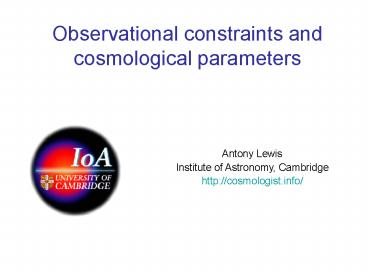Observational constraints and cosmological parameters - PowerPoint PPT Presentation
Title:
Observational constraints and cosmological parameters
Description:
ns 1 (2 sigma) CMB Degeneracies. TT. All. Main WMAP3 parameter results rely on polarization ... ns 1 at 2 sigma. LUQAS. Conclusions ... – PowerPoint PPT presentation
Number of Views:23
Avg rating:3.0/5.0
Title: Observational constraints and cosmological parameters
1
Observational constraints and cosmological
parameters
Antony Lewis Institute of Astronomy,
Cambridge http//cosmologist.info/
2
CMB PolarizationBaryon oscillations Weak
lensing Galaxy power spectrum Cluster gas
fraction Lyman alpha etc
Cosmological parameters
3
Bayesian parameter estimation
- Can compute P( ? data) using e.g. assumption
of Gaussianity of CMB field and priors on
parameters - Often want marginalized constraints. e.g.
- BUT Large n-integrals very hard to compute!
- If we instead sample from P( ? data) then it
is easy
Use Markov Chain Monte Carlo to sample
4
Markov Chain Monte Carlo sampling
- Metropolis-Hastings algorithm
- Number density of samples proportional to
probability density - At its best scales linearly with number of
parameters(as opposed to exponentially for brute
integration)
- Public WMAP3-enabled CosmoMC code available at
http//cosmologist.info/cosmomc (Lewis, Bridle
astro-ph/0205436) - also CMBEASY AnalyzeThis
5
WMAP1 CMB data alonecolor optical depth
Samples in6D parameterspace
6
Local parameters
Background parameters and geometry
- Energy densities/expansion rate Om h2, Ob
h2,a(t), w.. - Spatial curvature (OK)
- Element abundances, etc. (BBN theory -gt ?b/??)
- Neutrino, WDM mass, etc
- When is now (Age or TCMB, H0, Om etc. )
Astrophysical parameters
- Optical depth tau
- Cluster number counts, etc..
7
General perturbation parameters
-isocurvature-
Amplitudes, spectral indices, correlations
8
WMAP 1
CMB Degeneracies
WMAP 3
All
TT
ns lt 1 (2 sigma)
9
Main WMAP3 parameter results rely on polarization
10
CMB polarization
Page et al.
No propagation of subtraction errors to
cosmological parameters?
11
WMAP3 TT with tau 0.10 0.03 prior (equiv to
WMAP EE)
Black TTpriorRed full WMAP
12
ns lt 1 at 3 sigma (no tensors)?
Rule out naïve HZ model
13
Secondaries that effect adiabatic spectrum ns
constraint
SZ Marginazliation
Spergel et al.
Black SZ marge Red no SZ
Slightly LOWERS ns
14
CMB lensing
For Phys. Repts. review see
Lewis, Challinor astro-ph/0601594
Theory is robust can be modelled very accurately
15
CMB lensing and WMAP3
Black withred without - increases ns
not included in Spergel et al analysisopposite
effect to SZ marginalization
16
LCDMTensors
- No evidence from tensor modes
- is not going to get much betterfrom TT!
ns lt 1 or tau is high or there are tensors or the
model is wrong or we are quite unlucky
So
ns 1
17
Other CMB e.g. CBI combined TT data
(Dec05,Mar06)
Thanks Dick Bond
18
WMAP3 WMAP3CBIcombinedTTCBIpol CMBall
Boom03polDASIpol VSAMaximaWMAP3CBIcombinedTT
CBIpol
To really improve from CMB TT need good
measurement of third peak
19
CMB Polarization
Current 95 indirect limits for LCDM given
WMAP2dFHSTzregt6
WMAP1ext
WMAP3ext
Lewis, Challinor astro-ph/0601594
20
Polarization only useful for measuring tau for
near future Polarization probably best way to
detect tensors, vector modes Good consistency
check
21
Matter isocurvature modes
- Possible in two-field inflation models, e.g.
curvaton scenario - Curvaton model gives adiabatic correlated CDM
or baryon isocurvature, no tensors - CDM, baryon isocurvature indistinguishable
differ only by cancelling matter mode
Constrain B ratio of matter isocurvature to
adiabatic
-0.53ltBlt0.43
-0.42ltBlt0.25
WMAP32dfCMB
WMAP12dfCMBBBNHST
Gordon, Lewis astro-ph/0212248
22
Degenerate CMB parameters
Assume Flat, w-1
WMAP3 only
Use other data to break remaining degeneracies
23
Galaxy lensing
- Assume galaxy shapes random before lensing
Lensing
- In the absence of PSF any galaxy shape estimator
transforming as an ellipticity under shear is an
unbiased estimator of lensing reduced shear - Calculate e.g. shear power spectrum constrain
parameters (perturbationsangular at late times
relative to CMB) - BUT- with PSF much more complicated- have to
reliably identify galaxies, know redshift
distribution- observations messy (CCD chips,
cosmic rays, etc)- May be some intrinsic
alignments- not all systematics can be
identified from non-zero B-mode shear- finite
number of observable galaxies
24
CMB (WMAP1ext) with galaxy lensing (BBN prior)
CFTHLS
Contaldi, Hoekstra, Lewis astro-ph/0302435
Spergel et al
25
Lyman alpha WMAP
WMAP 1
bfp ns0.97, s80.88
WMAP 3
(both HST)
Does not favour running 0.005 0.03
Ly-alpha Viel Matteo, Haehnelt Martin G.,
Springel Volker, 2004, MNRAS, 354, 684
26
SDSS Lyman-alpha
white LUQAS (Viel et al)SDSS (McDonald et al)
SDSS, LCDM no tensors ns 0.965 0.015 s8
0.86 0.03 ns lt 1 at 2 sigma
LUQAS
27
Conclusions
- MCMC can be used to extract constraints quickly
from a likelihood function - CMB can be used to constrain many parameters
- Some degeneracies remain combine with other
data - WMAP3 consistent with many other probes, but
favours lower fluctuation power than lensing,
ly-alpha - ns lt1, or something interesting
- No evidence for running, esp. using small scale
probes

